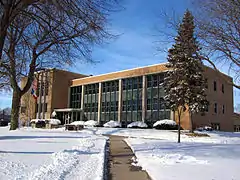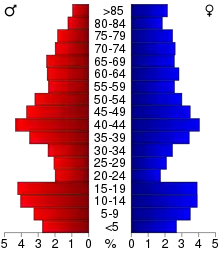Kossuth County, Iowa
Kossuth County (/kəˈsuːθ/) is a county in the U.S. state of Iowa. As of the 2010 census, the population was 15,543.[1] The county seat is Algona.[2]
Kossuth County | |
|---|---|
 | |
 Location within the U.S. state of Iowa | |
 Iowa's location within the U.S. | |
| Coordinates: 43°12′18″N 94°12′20″W | |
| Country | |
| State | |
| Founded | January 15, 1851 |
| Named for | Lajos Kossuth |
| Seat | Algona |
| Largest city | Algona |
| Area | |
| • Total | 974 sq mi (2,520 km2) |
| • Land | 973 sq mi (2,520 km2) |
| • Water | 1.6 sq mi (4 km2) 0.2% |
| Population (2010) | |
| • Total | 15,543 |
| • Estimate (2018) | 14,908 |
| • Density | 16/sq mi (6.2/km2) |
| Time zone | UTC−6 (Central) |
| • Summer (DST) | UTC−5 (CDT) |
| Congressional district | 4th |
| Website | www |
History
Kossuth County was founded on January 15, 1851. It was named after Lajos Kossuth, Regent-President of Hungary who went to exile to America following the war of independence of Hungary from the Habsburg Dynasty.[3] The county was enlarged northward in 1857 by the inclusion of the former Bancroft County.
Geography
According to the U.S. Census Bureau, the county has an area of 974 square miles (2,520 km2), of which 973 square miles (2,520 km2) is land and 1.6 square miles (4.1 km2) (0.2%) is water.[4] It is Iowa's largest county by area.
Major highways
 U.S. Highway 18
U.S. Highway 18.svg.png.webp) U.S. Highway 169
U.S. Highway 169 Iowa Highway 9
Iowa Highway 9 Iowa Highway 15
Iowa Highway 15 Iowa Highway 17
Iowa Highway 17
Adjacent counties
- Martin County, Minnesota (north)
- Faribault County, Minnesota (north)
- Winnebago County (northeast)
- Hancock County (southeast)
- Humboldt County (south)
- Palo Alto County (southwest)
- Emmet County (northwest)
National protected area
Demographics
| Historical population | |||
|---|---|---|---|
| Census | Pop. | %± | |
| 1860 | 416 | — | |
| 1870 | 3,351 | 705.5% | |
| 1880 | 6,178 | 84.4% | |
| 1890 | 13,120 | 112.4% | |
| 1900 | 22,720 | 73.2% | |
| 1910 | 21,971 | −3.3% | |
| 1920 | 25,082 | 14.2% | |
| 1930 | 25,452 | 1.5% | |
| 1940 | 26,630 | 4.6% | |
| 1950 | 26,241 | −1.5% | |
| 1960 | 25,314 | −3.5% | |
| 1970 | 22,937 | −9.4% | |
| 1980 | 21,891 | −4.6% | |
| 1990 | 18,591 | −15.1% | |
| 2000 | 17,163 | −7.7% | |
| 2010 | 15,543 | −9.4% | |
| 2018 (est.) | 14,908 | [5] | −4.1% |
| U.S. Decennial Census[6] 1790-1960[7] 1900-1990[8] 1990-2000[9] 2010-2018[1] | |||
2010 census
The 2010 census recorded a population of 15,543 in the county, with a population density of 15.9741/sq mi (6.16765/km2). There were 7,486 housing units, of which 6,697 were occupied.[10]
2000 census

At the 2000 census there were 17,163 people, 6,974 households, and 4,791 families in the county. The population density was 18 people per square mile (7/km2). There were 7,605 housing units at an average density of 8 per square mile (3/km2). The racial makeup of the county was 98.76% White, 0.11% Black or African American, 0.15% Native American, 0.35% Asian, 0.01% Pacific Islander, 0.29% from other races, and 0.34% from two or more races. 0.81%.[11] were Hispanic or Latino of any race.
Of the 6,974 households, 30.90% had children under the age of 18 living with them, 60.40% were married couples living together, 5.80% had a female householder with no husband present, and 31.30% were non-families. 28.70% of households were one person and 15.50% were one person aged 65 or older. The average household size was 2.42 and the average family size was 2.98.
The age distribution was 25.80% under the age of 18, 6.10% from 18 to 24, 24.30% from 25 to 44, 23.60% from 45 to 64, and 20.10% 65 or older. The median age was 41 years. For every 100 females, there were 95.30 males. For every 100 females age 18 and over, there were 94.00 males.
The median household income was $34,562 and the median family income was $41,159. Males had a median income of $30,191 versus $20,184 for females. The per capita income for the county was $16,598. About 7.50% of families and 10.20% of the population were below the poverty line, including 12.40% of those under age 18 and 8.60% of those age 65 or over.
Communities
Cities
Census-designated places
Townships
Population ranking
The population ranking of the following table is based on the 2010 census of Kossuth County.[12]
† county seat
| Rank | City/Town/etc. | Municipal type | Population (2010 Census) |
|---|---|---|---|
| 1 | † Algona | City | 5,560 |
| 2 | Bancroft | City | 732 |
| 3 | Swea City | City | 536 |
| 4 | Burt | City | 533 |
| 5 | Whittemore | City | 504 |
| 6 | Titonka | City | 476 |
| 7 | Wesley | City | 390 |
| 8 | Fenton | City | 279 |
| 9 | Lakota | City | 255 |
| 10 | Lu Verne (partially in Humboldt County) | City | 225 (261 total) |
| 11 | Lone Rock | City | 146 |
| 12 | Ledyard | City | 130 |
| 13 | St. Joseph | CDP | 61 |
| 14 | St. Benedict | CDP | 39 |
| 15 | Irvington | CDP | 38 |
| 16 | Sexton | CDP | 37 |
| 17 | West Bend (mostly in Palo Alto County) | City | 24 (785 total) |
Politics
| Year | Republican | Democratic | Third Parties |
|---|---|---|---|
| 2016 | 65.7% 5,653 | 29.6% 2,543 | 4.8% 411 |
| 2012 | 55.3% 4,937 | 43.2% 3,850 | 1.5% 136 |
| 2008 | 47.6% 4,329 | 50.8% 4,625 | 1.6% 146 |
| 2004 | 54.5% 5,042 | 44.6% 4,132 | 0.9% 84 |
| 2000 | 52.0% 4,612 | 44.6% 3,960 | 3.5% 306 |
| 1996 | 40.9% 3,477 | 47.4% 4,031 | 11.7% 997 |
| 1992 | 38.2% 3,464 | 40.4% 3,660 | 21.4% 1,935 |
| 1988 | 43.2% 3,938 | 55.9% 5,088 | 0.9% 81 |
| 1984 | 49.6% 4,872 | 49.3% 4,838 | 1.1% 104 |
| 1980 | 54.3% 5,568 | 37.1% 3,810 | 8.6% 884 |
| 1976 | 46.3% 4,653 | 51.7% 5,190 | 2.0% 203 |
| 1972 | 56.4% 5,841 | 42.4% 4,393 | 1.2% 124 |
| 1968 | 53.0% 5,350 | 43.5% 4,392 | 3.4% 347 |
| 1964 | 35.4% 3,776 | 64.6% 6,893 | 0.1% 5 |
| 1960 | 52.0% 6,278 | 48.1% 5,806 | 0.0% 0 |
| 1956 | 54.7% 6,680 | 45.2% 5,514 | 0.1% 10 |
| 1952 | 64.2% 7,765 | 35.8% 4,330 | 0.1% 10 |
| 1948 | 40.4% 4,186 | 58.3% 6,039 | 1.2% 128 |
| 1944 | 47.1% 4,918 | 52.6% 5,488 | 0.3% 27 |
| 1940 | 46.4% 5,639 | 53.5% 6,502 | 0.2% 24 |
| 1936 | 30.1% 3,569 | 68.0% 8,071 | 1.9% 223 |
| 1932 | 30.3% 3,075 | 68.2% 6,925 | 1.5% 148 |
| 1928 | 50.4% 4,878 | 48.9% 4,736 | 0.7% 72 |
| 1924 | 43.5% 3,806 | 15.7% 1,369 | 40.8% 3,572 |
| 1920 | 77.5% 6,018 | 21.7% 1,682 | 0.9% 69 |
| 1916 | 59.6% 2,647 | 39.4% 1,748 | 1.0% 44 |
| 1912 | 18.7% 857 | 39.5% 1,813 | 41.8% 1,916 |
| 1908 | 58.3% 2,612 | 40.7% 1,826 | 1.0% 44 |
| 1904 | 68.0% 3,001 | 30.6% 1,352 | 1.3% 59 |
| 1900 | 63.1% 3,122 | 35.9% 1,777 | 1.1% 52 |
| 1896 | 60.3% 2,930 | 38.3% 1,861 | 1.4% 68 |
References
- "State & County QuickFacts". United States Census Bureau. Archived from the original on June 7, 2011. Retrieved July 18, 2014.
- "Find a County". National Association of Counties. Archived from the original on May 31, 2011. Retrieved June 7, 2011.
- Gannett, Henry (1905). The Origin of Certain Place Names in the United States. Government Printing Office. pp. 177.
- "US Gazetteer files: 2010, 2000, and 1990". United States Census Bureau. February 12, 2011. Retrieved April 23, 2011.
- "Population and Housing Unit Estimates". Retrieved June 26, 2019.
- "U.S. Decennial Census". United States Census Bureau. Retrieved July 18, 2014.
- "Historical Census Browser". University of Virginia Library. Retrieved July 18, 2014.
- "Population of Counties by Decennial Census: 1900 to 1990". United States Census Bureau. Retrieved July 18, 2014.
- "Census 2000 PHC-T-4. Ranking Tables for Counties: 1990 and 2000" (PDF). United States Census Bureau. Retrieved July 18, 2014.
- "Population & Housing Occupancy Status 2010". United States Census Bureau American FactFinder. Retrieved May 19, 2011.
- "U.S. Census website". United States Census Bureau. Retrieved 2008-01-31.
- "2010 U.S. Census website". United States Census Bureau. Retrieved July 10, 2016.
- Leip, David. "Dave Leip's Atlas of U.S. Presidential Elections". uselectionatlas.org. Retrieved April 26, 2018.
